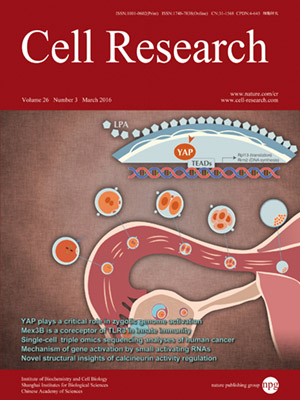
Volume 26, No 3, Mar 2016
ISSN: 1001-0602
EISSN: 1748-7838 2018
impact factor 17.848*
(Clarivate Analytics, 2019)
Volume 26 Issue 3, March 2016: 336-349
ORIGINAL ARTICLES
Cooperative autoinhibition and multi-level activation mechanisms of calcineurin
Sheng-Jie Li1,*, Jue Wang1,*, Lei Ma2,*, Chang Lu1, Jie Wang1, Jia-Wei Wu1,3 and Zhi-Xin Wang1,2
1MOE Key Laboratory of Protein Science, School of Life Sciences, Tsinghua University, Beijing 100084, China
2Institute of Biophysics, Chinese Academy of Sciences, Beijing 100101, China
3Tsinghua-Peking Center for Life Sciences, Tsinghua University, Beijing 100084, China
Correspondence: Zhi-Xin Wang, Tel: +86-10-6278-5505; Fax: +86-10-6279-2826 E-mail: zhixinwang@mail.tsinghua.edu.cn; Jia-Wei Wu, Tel: +86-10-6278-9387; Fax: +86-10-6279-2826(jiaweiwu@mail.tsinghua.edu.cn)
The Ca2+/calmodulin-dependent protein phosphatase calcineurin (CN), a heterodimer composed of a catalytic subunit A and an essential regulatory subunit B, plays critical functions in various cellular processes such as cardiac hypertrophy and T cell activation. It is the target of the most widely used immunosuppressants for transplantation, tacrolimus (FK506) and cyclosporin A. However, the structure of a large part of the CNA regulatory region remains to be determined, and there has been considerable debate concerning the regulation of CN activity. Here, we report the crystal structure of full-length CN (β isoform), which revealed a novel autoinhibitory segment (AIS) in addition to the well-known autoinhibitory domain (AID). The AIS nestles in a hydrophobic intersubunit groove, which overlaps the recognition site for substrates and immunosuppressant-immunophilin complexes. Indeed, disruption of this AIS interaction results in partial stimulation of CN activity. More importantly, our biochemical studies demonstrate that calmodulin does not remove AID from the active site, but only regulates the orientation of AID with respect to the catalytic core, causing incomplete activation of CN. Our findings challenge the current model for CN activation, and provide a better understanding of molecular mechanisms of CN activity regulation.
10.1038/cr.2016.14
FULL TEXT | PDF
Browse 2333


